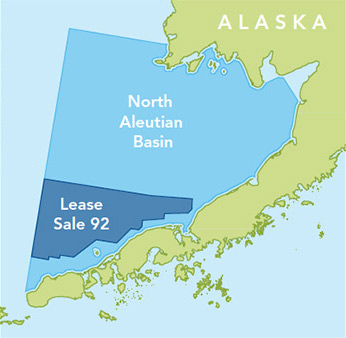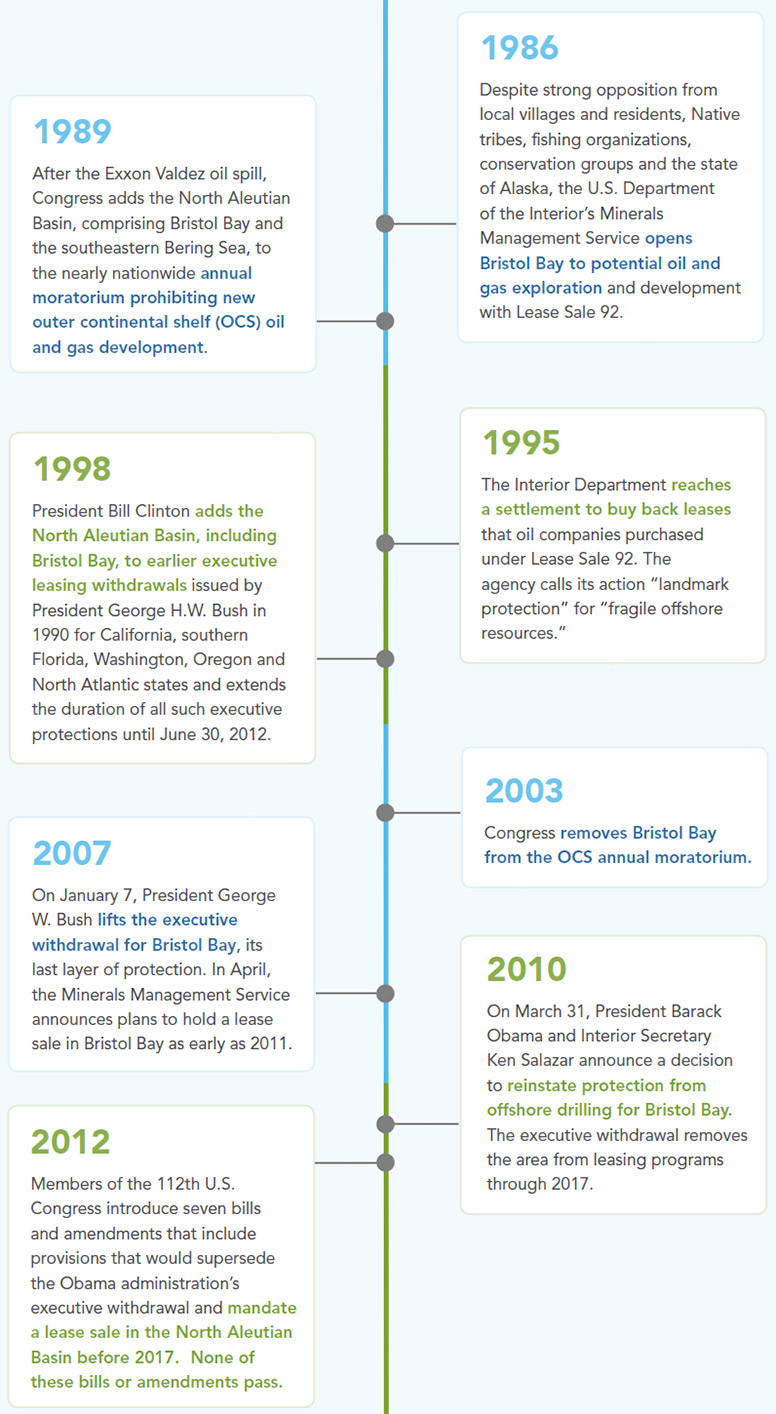Timeline: Oil and Gas Leasing in Bristol Bay
 Bristol Bay and the North Aleutian Basin, located in the eastern Bering Sea off southwest Alaska, is an extraordinarily productive marine ecosystem distinguished by its bountiful fisheries and exceptional ecological diversity. Rich, remote, wild, and incredibly productive, Alaska's Bristol Bay and southeast Bering Sea are America's seafood stronghold. The region's waters provide habitat for some of the largest runs of wild salmon on Earth and supply on average more than 40 percent of the total U.S. fish catch, including halibut, red king crab, Pacific cod, Tanner crab, flatfish, pollock, and sablefish. These renewable and sustainable fisheries are an economic engine for communities throughout Alaska, the Pacific Northwest, and the nation.
Bristol Bay and the North Aleutian Basin, located in the eastern Bering Sea off southwest Alaska, is an extraordinarily productive marine ecosystem distinguished by its bountiful fisheries and exceptional ecological diversity. Rich, remote, wild, and incredibly productive, Alaska's Bristol Bay and southeast Bering Sea are America's seafood stronghold. The region's waters provide habitat for some of the largest runs of wild salmon on Earth and supply on average more than 40 percent of the total U.S. fish catch, including halibut, red king crab, Pacific cod, Tanner crab, flatfish, pollock, and sablefish. These renewable and sustainable fisheries are an economic engine for communities throughout Alaska, the Pacific Northwest, and the nation.
Risks from Offshore Oil and Gas
Inevitable risks are associated with offshore oil and gas exploration and development, including catastrophic oil spills. With climate change already placing stress on marine ecosystems, we cannot afford to further jeopardize the jobs, food, and cultural heritage of Bristol Bay. Federal studies have predicted at least one major and numerous smaller spills if development occurs.1 Such spills could:
- Harm multiple year classes, or age-groups, of crab, salmon, and other fish as well as their prey, with potential population-level effects.
- Degrade or contaminate nursery habitat for halibut in the area with potential effects on the North Pacific population.
- Lead to the closure of multiple fisheries in the area.
- Harm marketing and branding and decrease value for seafood products over the long-term.
- Contaminate sheltered, intertidal habitats along much of the coastline for 30 years or longer.
Offshore seismic surveys employ explosive blasts of air, creating extreme underwater noise to locate oil and gas. Studies have shown that such surveys can have significant and sometimes lethal impacts on fish populations.2 Offshore oil and gas operations in Bristol Bay would also release thousands of tons of contaminated drilling muds and cuttings into the region's waters.
Read our Timeline of oil and gas leasing in Bristol Bay:
1 Minerals Management Service, April 2007. Final EIS for the 5-Year Outer Continental Shelf Leasing Program for 2007-2012. www.boem.gov/Oil-and-Gas-Energy-Program/Leasing/Five-Year-Program/2012-2017/History.aspx
2 CEF Consultants Ltd. November 1998. Exploring for Offshore Oil and Gas No. 2 of Paper Series on Energy and the Offshore. Halifax, NS. Accessed May 18, 2005. www.cefconsultants.ns.ca/2explore.pdf
Hirst, A.G., and P.G. Rodhouse. 2000. Impacts of geophysical seismic surveying on fishing success Reviews of Fish Biology and Fisheries 10:113-118.
McCauley, R., J. Fewtrell, and A. Popper. 2002 High Intensity Anthropogenic Sound Damages Fish Ears. Journal of the Acoustical Society of America. 113
(1):638- 642.
McCauley, et al. 2000. Marine Seismic Surveys: A Study of Environmental Implications. Australian Petroleum Production and Exploration Association
Journal. Pp. 692-708
Pamboris, X. Sept. 13, 2004. “Sonar and Seismic Exploration: A Major Headache for Whales.” Vancouver Aquarium Aqua News. Accessed June
23, 2005 at: www.vanaqua.org/aquanews/features/sonar.html.
Patin, S. 1999. Environmental Impact of the Offshore Oil and Gas Industry. East Northport, N.Y.: EcoMonitor Publishing.
Wardle et al. 2001. Effects of seismic air guns on marine fish. Continental Shelf Research 21:1005-1027.
Vancouver Aquarium Marine Science Center. Nov. 3, 2004. “Canada: Seismic Surveys a Danger to Marine Life, Report Warns.” Vancouver Aquarium Aqua
News. Accessed June 23, 2005 at: www.vanaqua.org/aquanew/fullnews.php?id=1722.







